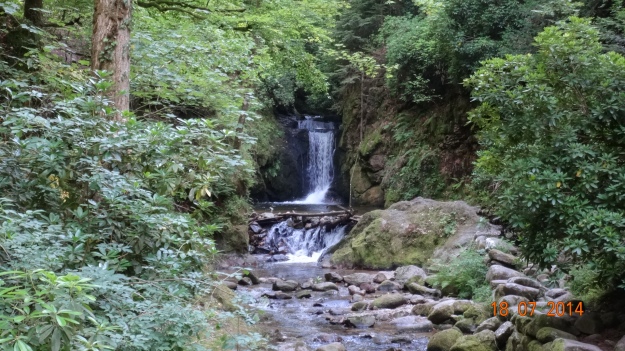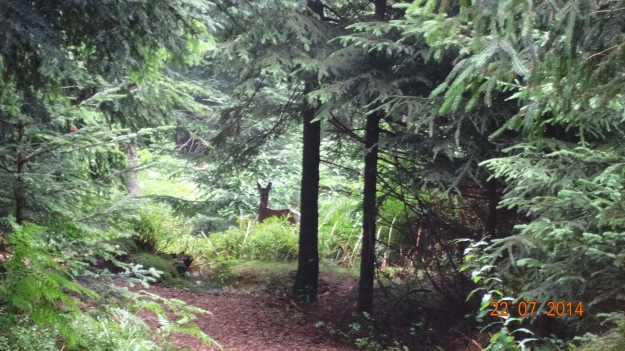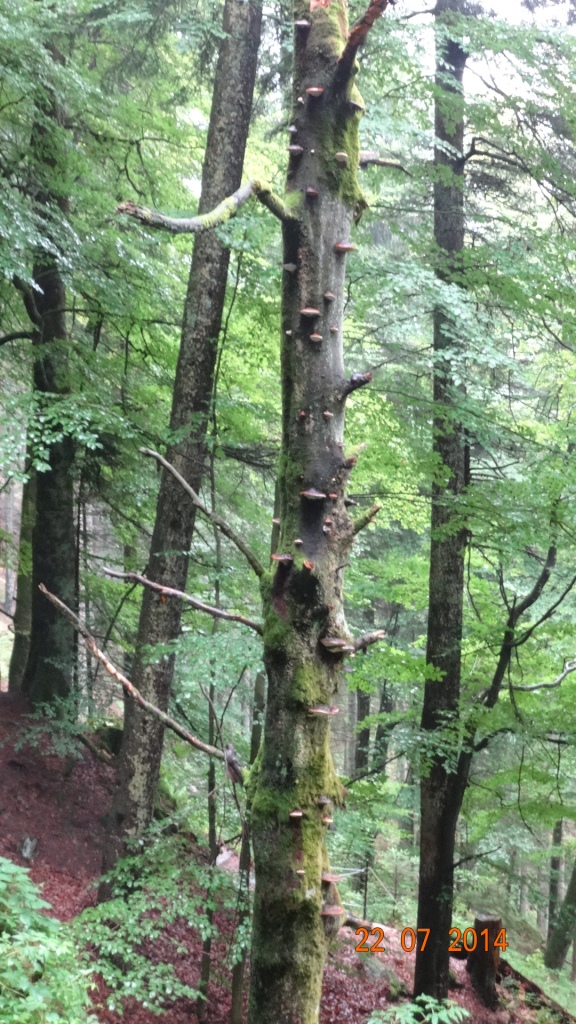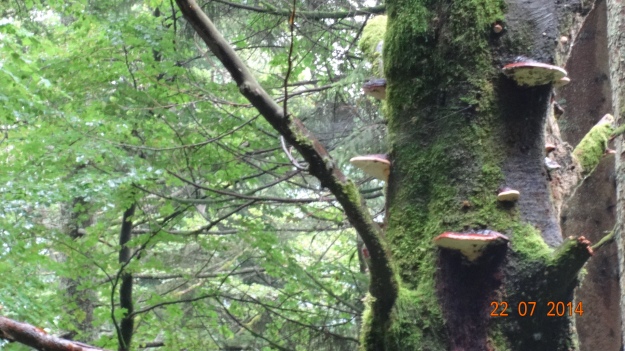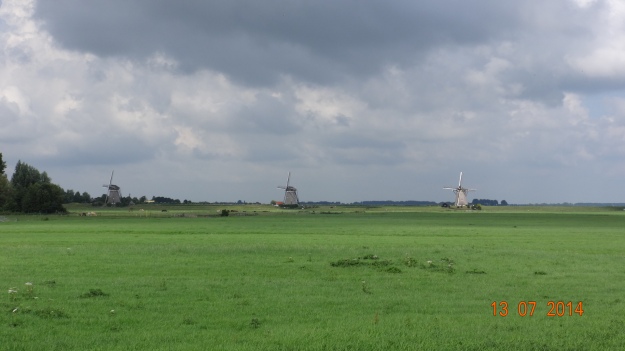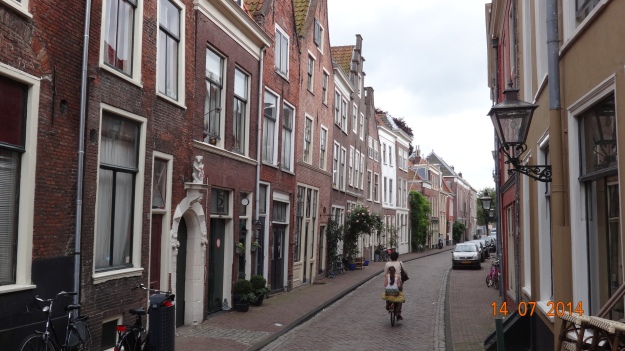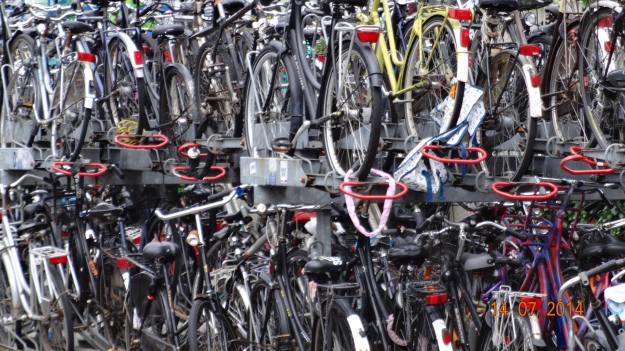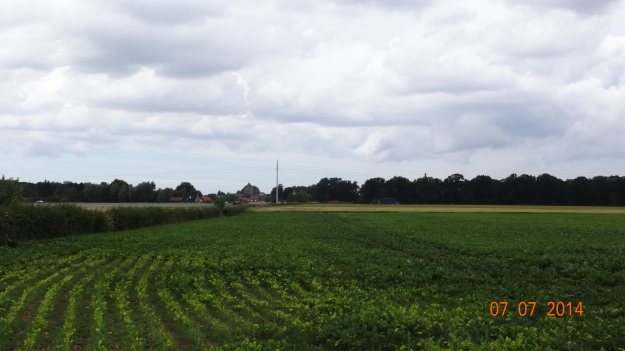We left The Hague on Wednesday 16th July, having spent a frustrating day, on the Tuesday trying to sort out our Garmin Sat Nav. To cut a long story short we ended up having to buy a new TomTom that had the whole of Europe already loaded. On the upside we got to spend an extra evening with Judith and also got to play in the park!
We crossed the border into Germany just before lunchtime and carried on until we reached the town Emmerich, which is built along the side on the Rhine; Big and wide, with a continual stream of huge barges, in both directions; some empty, some loaded to the gunnels. The town even had its own small container port.
There was a nice promenade along the river, with café and restaurants serving lunch. At the end of the promenade there was a park, in which we found a ‘knitted tree’, bringing back memories of the event at the end of March in Abergavenny
After buying some supplies at the local mid-week market (instantly forgetting any German we had so far tried to learn!), we headed back to the fast, smooth motorway, and were able to cover a good distance. The Germans certainly know how to build a road!
Our evening spot was near the village of Holzappel (SE Koblenz) at an official motorhome parking place next to a lake. Unfortunately they were charging 3 euros each to swim in it! So we abstained, tempting though it was in the heat!
We decided to take a more scenic route when we set off again the following afternoon. We followed the River Lahn along its picturesque valley until it reached the Rhine, and then turned south and followed the Rhine; busy with barges and a few pleasure boats. Rather them than us – pushing upstream against the current, which must have been several knots in the narrows judging by the wash against the buoys. How much control have you got going downstream, I wonder? There were many castles (Schlossen) on high vantage points along the river, many now in ruins, reminding you of this much fought over trade route.
We stopped in a riverside car park at Hattenheim, a pleasant enough spot, but there were a lot nicer places to stop further back, especially in the heat; probably upwards of 30C! Anyway we took our chairs, drinks and snacks to a shady spot by the river and watched the boats go by. The big barges have got quite extensive accommodation and often carry a couple of cars and maybe a boat for the owners’ / skipper’s use on the aft deck. I wonder when they get round to using them? The kids seemed to enjoy their fenced off playpens ‘atop the cargo; some complete with swings and slides!
On Friday morning we were on our way bright and early to cover the miles to Heidelberg in the relative cool. With the help of our database of suitable motorhome parking spots, we parked 4km from the centre, then cycled along the Neckar River until we reach the Altbrug (old bridge) which is the entrance into the Altstadt (old city). Having the bikes with us this trip has already made a huge difference; so much easier than struggling to find a parking spot nearer the centre of places we want to visit!
After a stop in a café for a cold ‘kleine bier und apfelsaftschole (Apple juice spritzer – Most important German for Elaine to learn!), we went to visit the Heiliggeistkirche – the Gothic Church of the Holy Ghost which was built from 1398 to 1441. There, in the cool of this impressive building we sat and listened to some ethereal organ music. Everyday at 12.30pm there is a 15 minute free organ recital.
Having been refreshed we headed out on to the streets of Heidelberg again, we enjoyed wandering through them, and admiring the old buildings. However the temperature was over 35C, so we decide against the 10min walk up the hill to the mainly ruined Scholss and headed back to Heidi.
Cycling back along the river there was enough of a breeze to make it bearable, but as soon as you stopped it was like an oven!
With the Heidi’s windows open to the max we headed down the motorway until Baden Baden and took the ‘Schwarzwalderhogestrasse into the Black Forest (Schwarzwald). It didn’t take long for a ‘waterfall and walks’ sign at the entrance of a shady car park persuaded us to stop!
A short walk along the stream to the waterfall and back via the ‘Gasthof Buthof, where we partook of a cold grosse bier und apfelsaftschole.
Saturday 19th July promised to be another hot hot day, so set out early, to avoid the heat, on a 11km Rundsweg, along forest tracks and up to the view-point Kruisfelsen at 840m
The walk through the forest was cool and dark so it was really lovely having the sun break through gaps in the trees, giving sunny glades
We admired the many neat wood piles. They seem to build them anywhere in the forests where the tree happens to have been felled. Surely it would make more sense to take them to at least near to where they are going to be used first??
As the temperature rose to above 30C again there was only one thing to do – find a sunny spot to have a refreshing dip!
When we lost the sun from the pool, we made our back along the river to Heidi, past where the pebble people live.
Sunday, we were back to ‘Winter’! with the temperature managing a mere 15C! and the Black Forest was covered in a misty cloud. So we moved on to the town of Freundenstadt. Which has the largest Marktplatz in the country, lined with cafes and shops. We felt however the original splendour of the square had been rather spoilt because it is now dissected by two busy main roads! – which the guidebook conveniently forgets to mention.
Although most of the buildings in the centre have, I believe, now been plastered over, they are, as you might imagine around here, predominantly timber frame. The majority are still covered in thousands of tiny wooden shingles, now painted over, often in bright colours. From the looks of some that are a ‘work in progress’, this has only been done in relatively recent times. Many of the impressive old farmhouses further out still retain their original ‘woody’ look.
As the day grew grayer and rainier we retired to the van, and splashed out on some WiFi.
Monday 21 July and the weather was little improved, so having done some shopping and filled and emptied appropriately Heidi’s tanks, we headed for a car park near the village of Kneibis Dorf, from where several walks were signposted. By late afternoon we felt the rain had eased enough to take a walk through the forest to the viewpoint overlooking the Ellbachsee.
While out walking we met some of the local wood folk
and spotted some local wildlife
and found plenty of heidelbeeren (bilberries) – enough to turn your tongue purple!
We got back to Heidi just before the heavens opened again and it rained heavily most of the night. It was still raining heavily when we awoke the next morning! However not being put off, when the rain eased at about midday, we set off on a 17km round walk via the Sankenbach Wasserfalle and Sankenbachsee. Everything is very very green! and covered in thick moss, lichens and fungi. Unlike many forestry areas, they seem to ‘manage’ and clear just enough here to let the light through and allow the smaller trees and plants to flourish. It would be difficult to do anything other than stick to the paths, everything is so abundant! It all looks very natural. Oh and did we mention GREEN!
There were also plenty of wild raspberries and strawberries to add to the bilberries, much to Elaine’s delight!
We managed to complete the walk in the relative dry – until we were about 500m from home! When we were soaked through in moments by a sudden cloud burst. We could hardly see Heidi across the car park! We thought nothing ventured nothing gained – so stripped off out of wet our clothes and had a shower in the rain, soap and all! We then warmed ourselves up with Bratwurst and chips for dinner!
Sorry, no shower pictures! hehe
Wednesday 23rd July, the sun was back, and so we planned a 22km cycle route through the villages, meadows and forest between Glatten and Freudenstadt.
Our starting point was in a very pleasant, a quiet walkers car park at Flosser-Ring just outside Glatten. We found the instructions from the information centre very unclear, so we went on several unexpected detours! This meant that we literally had to cycle through the meadows and over root covered walking tracks – not the smooth paths and forest tracks as promised! So with getting lost and some big big hills, we took six hours to do the tour rather than the suggest two on the leaflet! To revive our tired legs we made use of the local outdoor footspa in the little hamlet of Unteres Lauterbad. We spotted several of these with accompanying notices telling of the health benefits. The whole area is very popular for expensive health spa resorts – note we opted for the free version.
The next day with sun still shinning and after two busy days we declared Thursday a day of rest!; more paddling in cold streams for that added ‘health spa experience’ and enjoying the wildlife..
Next, to Schiltach, an attractive ancient town full of the (almost) original timber-framed buildings. Even better, for us, they provide a free carpark and free water and free electrics! specially for campervans. We walked around the old town spotting dates on buildings going back as far as the 1500’s, stopped for coffee in the impressive Markplatz, visited the town museum and then another sawmill/logging/leather tanning museum on the river.
Schiltach has had a very long and interesting history. The majority of the town has burned to the ground a number of times over the centuries, but has always been rebuilt, with increasing regulations (spaces between buildings, tiled roofs etc). It has been, and still is, an amazingly industrious place. The Kinzig river, that it stands on, was a major logging trade route down to the Rhine. Logs were rafted from here as far as Holland for the Dutch ship building industry. It was also a major leather tanning centre manufacturing, amoungst other things, waterproof thigh length boots for the loggers who would spend all day standing in the water tying the rafts together. If that wasn’t enough, it is also the home of Hansgrohe (taps and plumbing), VEGA pressure gauges and measuring equipment, BBS motor-racing wheel rims, One of the oldest pioneering dispensing chemists, and Junghans watch and clock-makers. Duralit bathroom porcelain is also nearby. A quite astounding list! I wish we’d stayed for longer! Both Hansgrohe and the Apotheke (chemist) also have free museums to visit and there are walks and cycleways both ways along the river. A fascinating and beautiful place!
More info: www.schiltach.de www.flosserpfad.de www.naturparkschwartzwald.de
And so to lunch..
Our last stop in The Black Forest was Triberg, home of Germany’s highest waterfall and largest cuckoo clock (and cuckoos apparently). The area surrounding the waterfall is fenced off and they’re charging 4euro each to walk up the path next to it!! It was busy and was only a long series of little waterfalls anyway. We didn’t bother. The rest of the town was not nearly so attractive as guidebooks might lead you to believe and is completely overrun by cuckoo clock and ‘tat’ shops.
Not impressed! We moved on to Donaueschingen (the source of the River Danube)…














